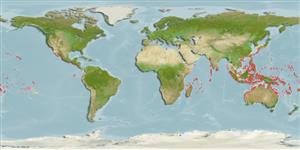Actinopterygii (ray-finned fishes) >
Beloniformes (Needle fishes) >
Hemiramphidae (Halfbeaks)
Etymology: Hyporhamphus: Greek, hypo = under + Greek, rhamphos = beak, bill (Ref. 45335).
Environment / Climate / Range
Ecology
Marine; reef-associated; depth range 0 - 6 m (Ref. 86942). Tropical, preferred ?
Indo-Pacific: Seychelles (Ref. 2334) through the East Indies, Borneo, Philippines, and New Guinea north to Hong Kong and Okinawa and eastward as far as Tuamoto Islands.
Size / Weight / Age
Maturity: Lm ? range ? - ? cm
Max length : 38.0 cm SL male/unsexed; (Ref. 54980); common length : 19.0 cm SL male/unsexed; (Ref. 9843)
Dorsal
spines
(total): 0;
Dorsal
soft rays
(total): 14-16;
Anal
spines: 0;
Anal
soft rays: 14 - 16;
Vertebrae: 56 - 60. Prolonged, beak-like lower jaw, contained in 4.2-5.9 times in SL and 0.95-1.4 times in head length; upper jaw short, triangular, and scaly, its width 0.6-0.9 times in its length; length of preorbital bone contained in 1.7-2.2 times in diameter of orbit and 1.0-1.4 times in length of upper jaw. Total number of gill rakers on first arch 33-47; dorsal and anal fin rays 14-16. Caudal fin forked, with lower lobe longer than upper (Ref. 9843).
Most common around islands and coral reefs (Ref. 6041). Found in schools at surface of lagoon and seaward reefs (Ref. 9710, 48635). Marketed fresh and dried salted (Ref. 9843).
Life cycle and mating behavior
Maturity | Reproduction | Spawning | Eggs | Fecundity | Larvae
Collette, B.B., 1974. The garfishes (Hemiramphidae) of Australia and New Zealand. Records of the Australian Museum 29(2):11-105. (Ref. 10988)
IUCN Red List Status (Ref. 115185)
CITES (Ref. 94142)
Not Evaluated
Threat to humans
Harmless
Human uses
Fisheries: commercial
More information
Common namesSynonymsMetabolismPredatorsEcotoxicologyReproductionMaturitySpawningFecundityEggsEgg development
ReferencesAquacultureAquaculture profileStrainsGeneticsAllele frequenciesHeritabilityDiseasesProcessingMass conversion
Tools
Special reports
Download XML
Internet sources
